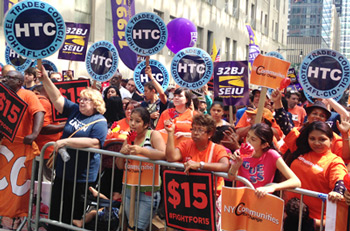

Vol. 79/No. 28 August 10, 2015

|
| Militant/Sara Lobman |
| Rally in New York July 22 after state wage board recommended $15 fast-food minimum wage. |
Cheers went up July 22 at a rally outside the hearing of the New York State Fast Food Wage Board as participants watching the televised proceedings on a big outdoor screen saw the board unanimously recommend raising the minimum wage for fast-food workers in the state to $15 an hour. Acting State Labor Commissioner Mario Musolino, who spoke at the rally, is expected to accept the increase and implement it.
The increase to $15 for fast-food workers — a 70 percent raise from the current $8.75 an hour state minimum wage — will be applied in increments, reaching $15 for New York City workers by Dec. 31, 2018, and for those outside the city by mid-2021. The wage hike applies to all workers in outlets that are part of chains of 30 or more restaurants that serve food and drinks paid for at counters by eat-in or take-out customers. Some 180,000 people are employed at fast-food restaurants in the state.
Los Angeles, San Francisco and Seattle have recently implemented $15 an hour minimum wage laws, also incrementally applied over several years.
University of California President Janet Napolitano announced July 22 that the minimum wage for direct and contract employees working more than 20 hours a week will be raised to $15 an hour by October 2017, a move that will have an impact on about 3,200 workers throughout the state.
On July 21 the Los Angeles County Board of Supervisors, in a room packed with people, voted to increase the minimum wage for county workers and those who work in unincorporated areas of the county from $9 to $15 an hour by 2020.
In Washington, D.C., the Board of Elections gave the go-ahead to a $15-an-hour initiative that will appear on the ballot next year if its supporters gather 23,000 signatures. The minimum hourly wage in the District of Columbia is currently $10.50.
The fight by fast-food workers for “$15 and a union” began in 2012 and has gained support since then. Thanksgiving weekend “Black Friday” protests at Walmart stores began the same year and also picked up steam.
On April 15 of this year thousands of workers in several hundred cities and towns across the U.S. and around the world marched in “Fight for $15” actions, with Walmart, airport, home health care and other workers joining the fast-food fighters.
Activists from the growing “Black Lives Matter” actions have joined the Fight for $15 actions, and “Black Lives Matter” is a popular chant and T-shirt slogan at rallies to raise the minimum wage.
Feeling the pressure, Walmart announced Feb. 19 it would raise starting pay to $9 per hour in April and another dollar by February 2016. Then on April 1 McDonald’s announced it would raise wages to at least $1 more than the local minimum wage for the 90,000 workers employed directly by the company. Some other retailers, including Target and TJ Maxx, have followed suit.
Union support
Unionized workers who earn more than $15 per hour have turned out in force to support raising the minimum wage. Contingents of the Hotel Trades Council, janitors from Service Employees International Union Local 32BJ, health care workers with 1199SEIU and members of the Laborers and Carpenters construction unions joined the march of thousands April 15 and the July 22 rally here.“I’m here to support the fast-food workers,” Brandon Brigman, 29, a porter in a commercial building in Manhattan and a member of Local 32BJ, told the Militant at that rally. “They need $15 an hour, and they need a union, too. There’s a big difference being in a union.”
Many at the rally who are not fast-food workers were buoyed by the increase and confident it can be spread to others.
“I get $10 an hour and I only get 36 hours a week,” home health care worker Oneka Rock, 37, told the Militant. “I couldn’t pay the $950 a month rent on the studio I share with my daughter, so we moved in with my mother.” Still, Rock is optimistic about the fight for $15. “My friend works in fast food for $8.75. I’m trying to get her to come to the protests, because only by doing that can we win anything.”
On another front in the fight for unions and higher wages, airport workers at Aviation Safeguard, a contractor that employs 1,200 baggage handlers, wheelchair attendants and security officers at Kennedy and LaGuardia airports, called off a planned one-day strike July 21 after the company agreed to stay neutral in their drive to be represented by Local 32BJ. Workers said they planned the strike to protest company intimidation against those fighting for higher wages and a union.
Deborah Liatos in Los Angeles contributed to this article.
Related articles:
Steel bosses push for steep concessions in contract talks
LA port drivers advance fight for union, wage hike
Verizon workers in 9 states and D.C. authorize strike
On the Picket Line
Front page (for this issue) | Home | Text-version home